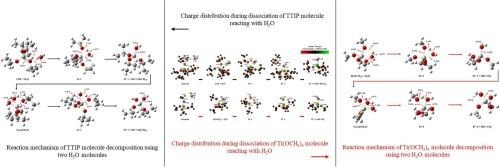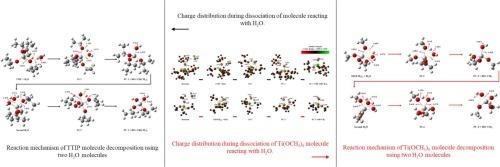热ALD-TiO2过程中TTIP和Ti(OCH3)4与H2O反应的分子动力学:DFT研究
IF 4.3
2区 工程技术
Q2 ENGINEERING, CHEMICAL
引用次数: 0
摘要
研究了钛(IV)异丙醇(TTIP)和甲氧基钛(IV) [Ti(OCH3)4]分别作为钛前驱体和水作为氧剂的反应机理。假设了原子层沉积(ALD) -TiO2薄膜沉积过程,重点研究了其与羟基分子和钛有机键相互作用的分子动力学。通过密度泛函理论(DFT)计算得到的计算结果表明,前驱体分子在与水反应过程中形成键和相互作用的顺序与Si(100)表面的吸附机理一致。在反应的每个阶段的相对能量的差异,使他们在反应速率和过程温度方面进行比较。当与H2O分子相互作用时,TTIP和Ti(OCH3)4分子的平均激活势垒分别为15.9和14.5 kcal/mol,表明Ti(OCH3)4可以在较低的温度下进行分解。这一观察结果与TTIP和Ti(OCH3)4分子在羟基化Si(100)表面的吸附行为一致,它们分别表现出13.4和11.5 kcal/mol的活化屏障。这些发现支持了一个假设,即具有较低分解障碍的前体分子更容易吸附到底物表面,并且通常需要较低的工艺温度。这些见解使我们能够根据这些钛前体与水分子的相互作用来预测其吸附机制。基于分子行为,它应该为各种前驱体在不同衬底表面的反应机理提供一个框架,以生产广泛的ALD金属氧化物薄膜。本文章由计算机程序翻译,如有差异,请以英文原文为准。


Molecular dynamics of TTIP and Ti(OCH3)4 reaction with H2O in thermal ALD–TiO2 Processes: A DFT study
The reaction mechanisms between Titanium(IV) isopropoxide (TTIP), Titanium(IV) methoxide [Ti(OCH3)4] as titanium precursors and water as oxygen agent respectively, were investigated. Atomic layer deposition (ALD)–TiO2 thin film deposition process was assumed focusing on their molecular dynamics through interaction with hydroxyl molecule and titanium organic bonds. Based on the computational results obtained by performing the density functional theory (DFT) calculations, the sequence of bonds formation and interaction in these precursor molecules during their reaction with water align with the adsorption mechanism on the Si(100) surface. The differences in the relative energy at each stage of the reaction allow their comparison in terms of the reaction rate and process temperature. When interacted with the H2O molecule, the ligands of TTIP and Ti(OCH3)4 molecules dissociate with average activation barriers of 15.9 and 14.5 kcal/mol, respectively, indicating that Ti(OCH3)4 can undergo decomposition at lower temperatures compared to TTIP. This observation aligns with the adsorption behavior of TTIP and Ti(OCH3)4 molecules on hydroxylated Si(100) surfaces, which exhibit activation barriers of 13.4 and 11.5 kcal/mol, respectively. These findings support the hypothesis that precursor molecules with lower decomposition barriers tend to adsorb more readily onto substrate surfaces and generally require lower process temperatures. These insights enabled us to predict the adsorption mechanisms of these titanium precursors based on their interactions with water molecules. Based on molecular behavior, it should provide a framework for the reaction mechanisms of various precursors on different substrate surfaces for producing a broad range of ALD metal oxide thin films.
求助全文
通过发布文献求助,成功后即可免费获取论文全文。
去求助
来源期刊

Chemical Engineering Science
工程技术-工程:化工
CiteScore
7.50
自引率
8.50%
发文量
1025
审稿时长
50 days
期刊介绍:
Chemical engineering enables the transformation of natural resources and energy into useful products for society. It draws on and applies natural sciences, mathematics and economics, and has developed fundamental engineering science that underpins the discipline.
Chemical Engineering Science (CES) has been publishing papers on the fundamentals of chemical engineering since 1951. CES is the platform where the most significant advances in the discipline have ever since been published. Chemical Engineering Science has accompanied and sustained chemical engineering through its development into the vibrant and broad scientific discipline it is today.
 求助内容:
求助内容: 应助结果提醒方式:
应助结果提醒方式:


